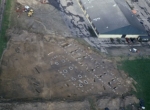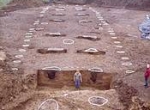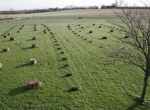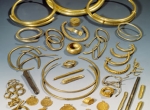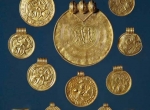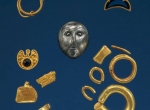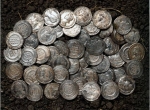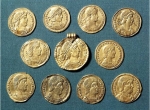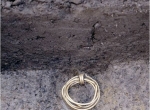Gudme
Gudme, south-western Funen (Denmark). The name means “home of the god”. A settlement complex interpreted as a central place, more than 1 km2 in area, from the Late Roman Period (3rd century) to the Early Middle Ages. At the peak of its activity during the 4th and the 5th century there were some 50 farmsteads. Nine occupation levels and six areas were distinguished at Gudme: G. I – G. VI. In the northern area there were two large hall buildings: one measuring 47 x 10 m, with roof trusses supported on posts 80 cm in diameter, and a smaller associated building; several phases of occupation and reconstruction were identified. The larger building was in use from the late 3rd until the beginning of the 5th century, the smaller until the middle of the 6th century. Their purpose is characterised by the nature of remarkable deposits discovered in and around the two buildings suggests that they had an administrative and ceremonial function, helping to identify them as the seat of the local power elite.
The first discoveries of gold objects from G. and its region date to the 16th c. A hoard of 49 Migration Period artefacts discovered in the early 1830s at Broholm near G. was submitted to C. J. Thomsen and became the highlight of the newly created royal museum in Copenhagen. The investigation of G. and its region made in the late 20th century has been one of the key research projects of Danish archaeology. Archaeological excavation and, especially, metal detector surveys, resulted in the discovery of the remains of farmsteads, evidence of local crafts activity, an impressive quantity of Roman and Frankish imports and last but not least, of several hoards, more notably – of hacksilver, second-century denarii, fourth-century solidi →Solidus (G. I) and siliquae (G. III and G. IV), Scandinavian bracteats →Scandinavian Bracteat (G. II) and Arabic dirhams from the 10th century (G. IV). A total of more than 1000 Roman coins were discovered, mostly, second-century denarii, usually stray finds recovered from the plough soil. The presence of Roman coins, imported objects and the other finds indicates lively exchange during the 3rd up to 6th centuries with the western provinces and the state of the →Franks (Rhineland) as well as with south-eastern Europe, e.g., the Lower Danube region.
Two kilometres to the east of G. lies the cemetery Møllegårdsmarken, the largest Roman Period grave-field on Funen. A site discovered in 1986 at Lundeborg on the seacoast on the banks of the water course of Tange Å some 3.5 km from G. is interpreted as a small seasonal trading place, mostly in use during the 3rd and the 4th cc. through to the Migration Period (C1-D), with evidence on the working of iron, precious metals and amber, etc. The impressive quantity of finds from archaeological excavation and metal detecting: Roman objects such as glass beads, fragments of terra sigillata pottery, 174 coins, mostly second-century denarii, also, some siliquae from the 4th century and an aureus, gold and silver bars, weights, glass fragments and boat rivets. The latter suggests that the site at Lundeborg has been a port. Møllegårdsmarken, G. and Lundeborg were connected by a road.
The settlement complex at Gudme served as a transregional power and religious central place, similarly to the complexes →Sorte Muld II on Bornholm, →Uppåkra in Scania, →Jakuszowice in Lesser Poland, →Janków in Greater Poland and →Gąski in Kuyavia.
AB
Literature: K. Randsborg, Beyond the Roman Empire: archaeological discoveries in Gudme on Funen, Denmark, Oxford Journal of Archaeology 9, 1990, p. 355-366; P. O. Nielsen, K. Randsborg, H. Thrane (eds.), The Archaeology of Gudme and Lundeborg, Copenhagen 1994; B. Hårdh & L. Larsson (eds.), Central Places in the Migration and Merovingian Periods. Papers from the 52nd Sachsensymposium Lund, Uppåkrastudier 6, Lund 2002; H. W. Horsnæs, Crossing Boundaries. An Analysis of Roman Coins in Danish Context. Vol. 1: Finds from Sealand, Funen and Jutland, Publications of the National Museum Studies in Archaeology and History 18:1, Copenhagen 2010, p. 94-105.



